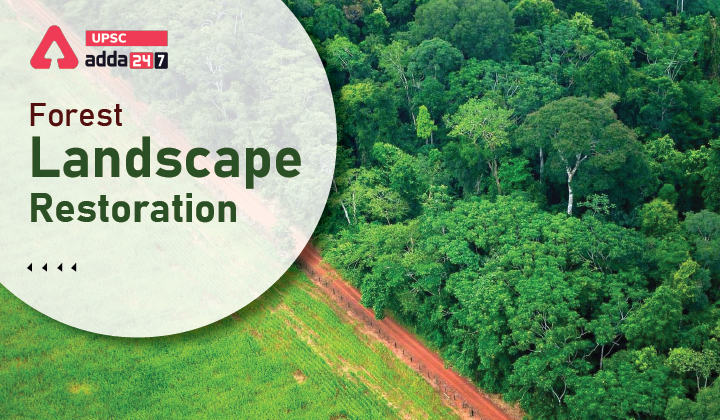Table of Contents
Forest Landscape Restoration: Relevance
- GS 3: Conservation, environmental pollution and degradation, environmental impact assessment.
Forest conservation: Context
- Recently, in a glaring example of community effort, about 100 women, employed under the Mahatma Gandhi National Rural Employment Guarantee Act (MGNREGA), working with 50 young people from a local club, and district administration planted trees during the World Environment Day.
Tress restoration: About Van Mahotsav
- Van Mahotsav literally means “celebrate the forest”.
- The history of Van Mahotsav Day goes back to July 1947, when it was first organised by the Punjabi botanist, M.S. Randhawa.
- Subsequently, in 1950, M. Munshi, an environmentalist and Union Minister of Agriculture and Food, expanded its reach and national scope.
- According to the International Union for Conservation of Nature (IUCN), deforestation and forest degradation contribute around 12% of global greenhouse gas (GHG) emissions. The total area occupied by primary forests in India has decreased by 3.6%.
- Therefore, more forests need to be created and restored. However, there is much debate about the efforts around tree planting.
What is Forest landscape restoration?
- Nearly two billion hectares of degraded land in the world (and 140 million hectares in India) have scope for potential restoration as forest land.
- Earlier, the governments have relied on afforestation and reforestation as a means of establishing trees on non-treed land.
- These strategies, however, have been evolving in recent days.
- Forest Land Restoration means the process of regaining ecological functionality and improving human welfare across deforested or degraded forest landscapes.
- This approach keeps in mind multiple lands uses and people’s needs in the short and long terms.
- Forest landscape restoration is an attempt to involve communities in the process of designing and executing mutually advantageous interventions for the upgradation of landscapes.
- While implementing forest land landscape, ensuring diversity while planting trees are imperative.
- Natural forests with diverse native tree species are more efficient in sequestering carbon than monoculture tree plantations.
- Planting diverse species is also healthier for local communities and their livelihoods.
Benefits of Forest Landscape Restoration
- Environmental benefits: Forests regulates ecosystems. It influences the carbon cycle and mitigates the effects of climate change.
- Annually, forests absorb roughly 2.6 billion tonnes of carbon dioxide. This absorption includes nearly 33% of the carbon dioxide released from burning fossil fuels.
- Benefits for human: Millions of lives and livelihoods are intertwined with our forests. Forests are a boon for local communities and their livelihoods by functioning as a resource base for goods and services.
- Multi-dimensional benefits: According to World Resources Institute, forest ecosystems enrich soil fertility and water availability, enhancing agricultural productivity, and in turn the rural economy.
- Tree planting prevents erosion and stems flooding.
- Women empowerment: Sustainable Forest crops reduce food insecurity and empower women, allowing them to gain access to more nutritional diets and new income streams.
- Reduces migration: Agroforestry lessens rural-to-urban migration and contributes to an increase in resources and household income.
Indian programmes for forest restoration
International efforts
- The span 2021-2030 is the UN Decade on Ecosystem Restoration, emphasising efforts to restore degraded terrestrial ecosystems including forests.
- India joined the Bonn Challenge in 2015, pledging to restore 26 million hectares of degraded and deforested land by 2030.
- In 2011, the Bonn Challenge was launched with a global goal to restore 150 million hectares of degraded and deforested landscapes by 2020 and 350 million hectares by 2030.
- An additional carbon sink of 2.5 billion-3 billion tonnes of carbon dioxide equivalent through forest and tree cover is to be created by 2030.
National efforts
- Various schemes like Compensatory Afforestation, the National Afforestation Programme, the National Mission for a Green India (Green India Mission), the Nagar Van scheme and the Forest Fire Prevention and Management Scheme was launched for trees restoration.
- Focus on youth via the Green Skill Development Programme who aspire to attain employment in the environment and forest sectors.
Read current affairs for UPSC





 TSPSC Group 1 Question Paper 2024, Downl...
TSPSC Group 1 Question Paper 2024, Downl...
 TSPSC Group 1 Answer key 2024 Out, Downl...
TSPSC Group 1 Answer key 2024 Out, Downl...
 UPSC Prelims 2024 Question Paper, Downlo...
UPSC Prelims 2024 Question Paper, Downlo...
